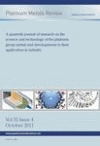-
oa Platinum Recovery by Palladium Alloy Catchment Gauzes in Nitric Acid Plants
The Mechanism of Platinum Recovery
- Source: Platinum Metals Review, Volume 40, Issue 2, Apr 1996, p. 80 - 87
-
- 01 Jan 1996
Abstract
Since the introduction of palladium-gold catchment gauzes for the recovery of the platinum lost from the catalyst gauzes used in the manufacture of nitric acid, the mechanism by which these high palladium content alloys catch and recover the platinum has been of interest to both researchers and manufacturers, alike. Using analyses of the surface chemical species which form on palladium, both in flowing oxygen and during the ammonia oxidation reaction, this paper describes how the surface of the palladium, at temperatures above 800°C, is a multilayer structure with the bright palladium metal surface being covered by a thin layer of palladium metal vapour and then by a layer of palladium oxide vapour. The mechanism of the platinum recovery is related to the surface state of the palladium, and the high recovery rate by the palladium alloy catchment gauze is attributed to this unique multilayer structure and to the ability of palladium to reduce platinum oxide. Damage to either the surface multilayer structure or the oxidation characteristics of palladium decreases the platinum recovery rate. Thus, catchment gauzes made from palladium alloys containing high concentrations of base metal solutes, such as nickel, cannot be expected to have such a high platinum recovery rate.


